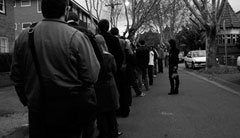Designing Waits That Work
Designers at restaurants, theme parks and elsewhere have investigated how to make waiting in line more pleasant. What they have learned has profound implications for all managers.
Topics

Image courtesy of Flickr user Fernando de Sousa
At some point, every manager has had to tell someone to wait. We all have to wait sometimes. It’s a simple matter of timing and resources. Whenever two systems interact, one is invariably ready before the other. In the factory, this disparity can lead to stockpiles of goods or bottlenecks. When people are involved, it can give rise to inefficiency and anger. This is no good for customers or employees. But the psychological impact of waits can be managed, and studies in design show us how to do it.
My introduction to design started with my studies of fundamental principles of interaction to enhance the use of technology.1 Now, as I teach and consult on the applications of these principles to business, I apply them to many aspects of customer experience.
In places where waits are required, these principles can not only make waiting more pleasant but can also make it feel like not waiting at all. Sometimes inducing a wait can improve the customer experience. When waits are inevitable, the research shows, the goal should be to optimize the experience for both customers and employees, thereby enhancing customer satisfaction and reducing employee stress and turnover. What this research has revealed can help managers in many situations, even those not involving lines.
Manage Understanding
While writing this article I was an unwilling participant in a situation that illustrated many of its principles. I boarded an airplane that was scheduled to take me from San Francisco to Chicago, but the departure was delayed while airline technicians worked in the back. Frequent announcements told us that the rear toilets were not working, but we would leave as soon as they were fixed. Then the crew told us that we might leave without the toilets operating. Every 20 minutes I received a text message on my cell phone updating the departure time. After an hour of continual maintenance effort and announcements, the captain explained that he had decided that we should not fly with only one operating toilet. Instead, we would disembark and leave later on another airplane. Despite the uncertainty, the passengers were calm and understanding. My seatmate told me that it was reassuring that the captain himself had made the final announcement and explained his reasoning.
References
1. D.A. Norman, “The Design of Everyday Things” (New York: Basic Books, 2002); and D.A. Norman, “Emotional Design: Why We Love (or Hate) Everyday Things” (New York: Basic Books, 2004).
2. R.I. Sutton, “Feelings About a Disneyland Visit: Photography and the Reconstruction of Bygone Emotions,” Journal of Management Inquiry 1, no. 4 (December 1992): 278-287.
3. T.R. Mitchell, L. Thompson, E. Peterson and R. Cronk, “Temporal Adjustments in the Evaluation of Events: The ‘Rosy View,’” Journal of Experimental Social Psychology 33, no. 4 (July 1997): 421-448; T. Mitchell and L. Thompson, “A Theory of Temporal Adjustments of the Evaluation of Events: Rosy Prospection & Rosy Retrospection,” in “Advances in Managerial Cognition and Organizational Information-Processing,” Vol. 5, eds. C. Stubbart, J. Porac and J. Meindl (Greenwich, Connecticut: JAI Press, 1994), 85-114.
4. K.A. Braun-LaTour, M.S. LaTour, J.E. Pickrell and E.F. Loftus, “How and When Advertising Can Influence Memory for Consumer Experience,” Journal of Advertising 33, no. 4 (December 2004): 7-25.
5. R.B. Chase and S. Dasu, “Want to Perfect Your Company’s Service? Use Behavioral Science,” Harvard Business Review 79, no. 6 (June 2001): 78-84.
i. J.L. Watson, “Cultural Globalization,” Encyclopædia Britannica (2008).

Comments (8)
mikesdebp
Alice Newton
mikeWood
mikediesen
mikediesen
Anonymous
walterrsmith
Anonymous